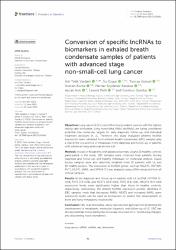| dc.contributor.author | Tetik Vardarlı, Aslı | |
| dc.contributor.author | Özgür, Su | |
| dc.contributor.author | Göksel, Tuncay | |
| dc.contributor.author | Korba, Korcan | |
| dc.contributor.author | Soydaner Karakuş, Hardar | |
| dc.contributor.author | Pelit, Levent | |
| dc.contributor.author | Aşık, Aycan | |
| dc.date.accessioned | 2023-08-01T12:54:43Z | |
| dc.date.available | 2023-08-01T12:54:43Z | |
| dc.date.issued | 2023 | en_US |
| dc.identifier.citation | Tetik Vardarlı A, Ozgur S, Goksel T, Korba K, Karakus HS, Asık A, Pelit L, Gunduz C. Conversion of specific lncRNAs to biomarkers in exhaled breath condensate samples of patients with advanced stage non-small-cell lung cancer. Front Genet. 2023 Jun 22;14:1200262. doi: 10.3389/fgene.2023.1200262. PMID: 37424727; PMCID: PMC10324032. | en_US |
| dc.identifier.other | PMCID: PMC10324032 | |
| dc.identifier.uri | https://hdl.handle.net/20.500.12809/10826 | |
| dc.description.abstract | Lung cancer (LC) is one of the most prevalent cancers with the highest fatality rate worldwide. Long noncoding RNAs (lncRNAs) are being considered potential new molecular targets for early diagnosis, follow-up, and individual treatment decisions in LC. Therefore, this study evaluated whether lncRNA expression levels obtained from exhaled breath condensate (EBC) samples play a role in the occurrence of metastasis in the diagnosis and follow-up of patients with advanced lung adenocarcinoma (LA). Methods: A total of 40 patients with advanced primary LA and 20 healthy controls participated in the study. EBC samples were collected from patients (during diagnosis and follow-up) and healthy individuals for molecular analysis. Liquid biopsy samples were also randomly obtained from 10 patients with LA and 10 healthy people. The expression of lncRNA genes, such as MALAT1, HOTAIR, PVT1, NEAT1, ANRIL, and SPRY4-IT1 was analyzed using cfRNA extracted from all clinical samples. Results: In the diagnosis and follow-up of patients with LA, lncRNA HOTAIR (5-fold), PVT1 (7.9-fold), and NEAT1 (12.8-fold), PVT1 (6.8-fold), MALAT1 (8.4-fold) expression levels were significantly higher than those in healthy controls, respectively. Additionally, the distinct lncRNA expression profiles identified in EBC samples imply that decreased ANRIL-NEAT1 and increased ANRIL gene expression levels can be used as biomarkers to predict the development of bone and lung metastases, respectively. Conclusion: EBC is an innovative, easily reproducible approach for predicting the development of metastases, molecular diagnosis, and follow-up of LC. EBC has shown potential in elucidating the molecular structure of LC, monitoring changes, and discovering novel biomarkers. | en_US |
| dc.item-language.iso | eng | en_US |
| dc.publisher | PMC | en_US |
| dc.relation.isversionof | 10.3389/fgene.2023.1200262 | en_US |
| dc.item-rights | info:eu-repo/semantics/openAccess | en_US |
| dc.subject | Biomarker | en_US |
| dc.subject | cfRNA | en_US |
| dc.subject | Ebc | en_US |
| dc.subject | lncRNA | en_US |
| dc.subject | Lung cancer | en_US |
| dc.title | Conversion of specific lncRNAs to biomarkers in exhaled breath condensate samples of patients with advanced stage non-small-cell lung cancer | en_US |
| dc.item-type | article | en_US |
| dc.contributor.department | MÜ, Tıp Fakültesi, Temel Tıp Bilimleri Bölümü | en_US |
| dc.contributor.authorID | 0000-0002-4123-4175 | en_US |
| dc.contributor.institutionauthor | Aşık, Aycan | |
| dc.identifier.volume | 14 | en_US |
| dc.relation.journal | Frontiers in Genetics | en_US |
| dc.relation.publicationcategory | Makale - Uluslararası Hakemli Dergi - Kurum Öğretim Elemanı | en_US |


















